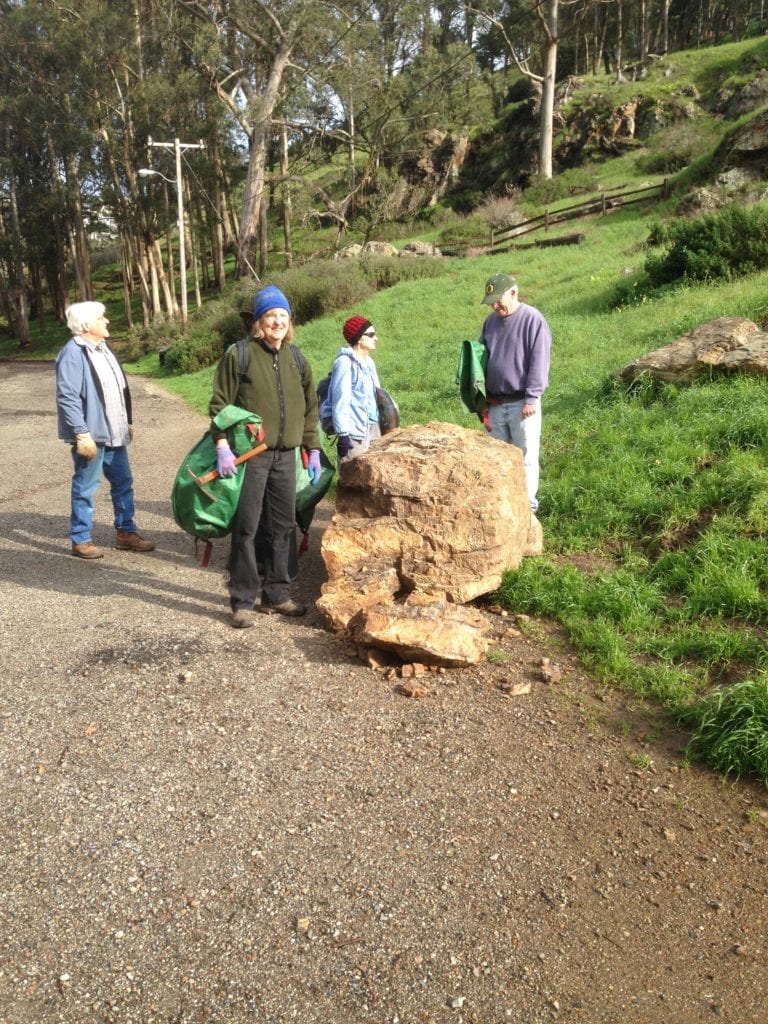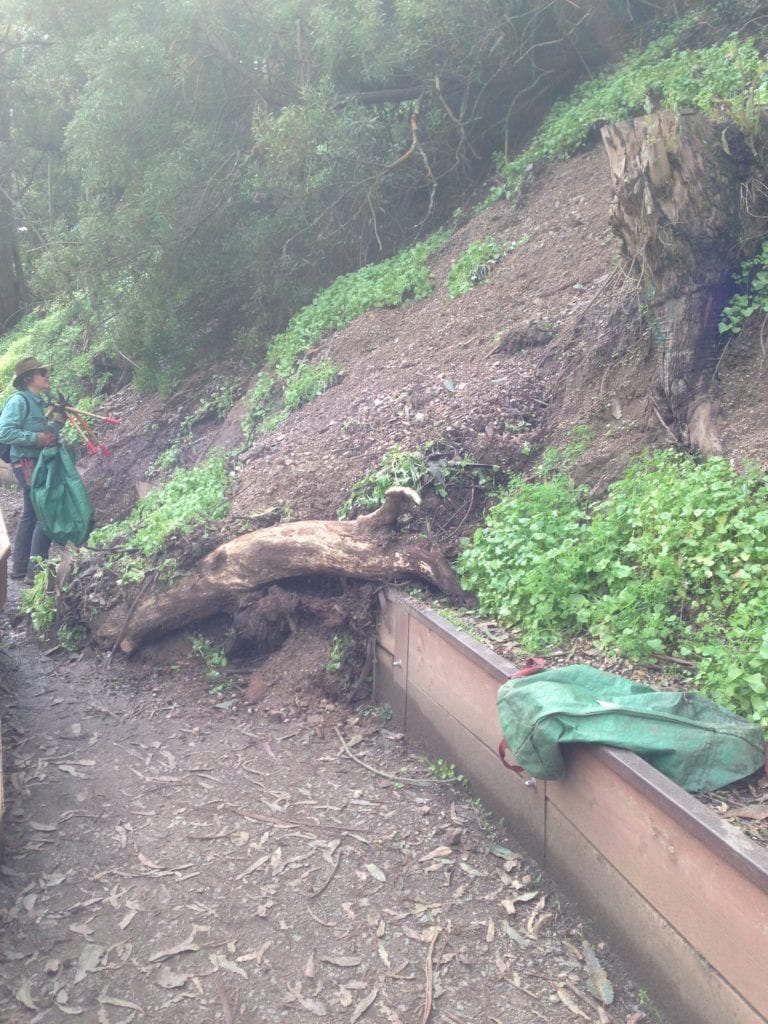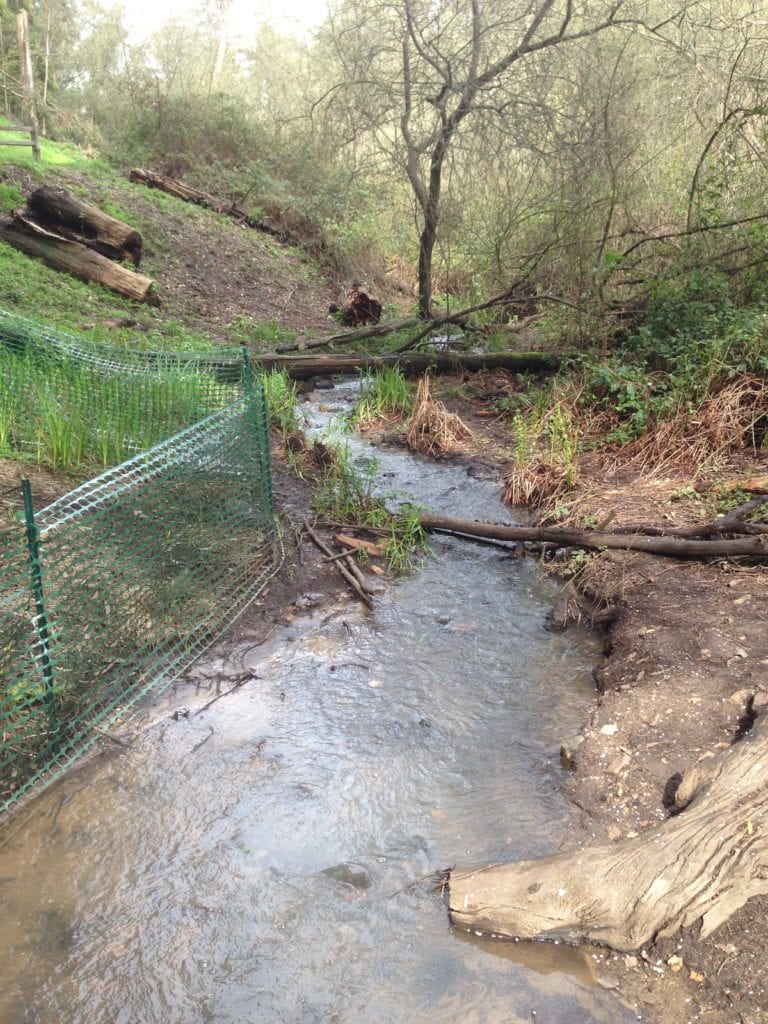
By Murray Schneider
A huge chunk of Franciscan chert rock plummeted from the eastern slopes of Glen Canyon to Alms Road sometime between February 15 and February 22. The ominous-looking boulder greeted a group of volunteers from Friends of Glen Canyon Park as they made their way along the fire road, destined for thickets of invasive mustard they were scheduled to remove north of Radish Hill along Coyote Crags Trail.
It is unclear if the recent deluge of winter rain, which has witnessed Islais Creek rise and run rapidly, was responsible for the giant rock rocketing down the hillside.
One fact is indisputable. If the boulder had careened down the drenched hillside while recreational dog walkers trailed behind their canines, a catastrophe might have taken place.
Curious, six Recreation and Park volunteers circled the boulder and studied it.
“Any natural area can be dangerous, especially rock canyons, said Rob Oreglia, who has volunteered with Rec and Park’ Natural Resources Division for fifteen years. “Chert fractures.”
Borrowing an expression from our national pastime, the Noe Valley resident continued:
“Mother nature has a way of batting clean up!”
“While the boulder will remain where it is, we’ve started to clear the mudslide,” said Joey Kahn, Rec and Park spokesperson. “It will take a couple of weeks, but the path is now clear and passable.”
If anyone needed proof that Glen Canyon is not an ornamental rose garden, the inert rock is ample evidence.
Glen Canyon is 70 acres of wilderness in the heart of the City.
It is the home to great-horned owls and red-tailed hawks, rare California grasses, oak and redwood trees, wild coyotes, bountiful California wildflowers, and the second longest above ground creek in the City.
Stillings Avenue’s Jim Hanratty, a Natural Resources Division volunteer, toed the boulder, confirming that Glen Park’s open space is also home to craggy chert outcrops.
Happily, most of the rock formation remained visible, in tact, looming large below Berkeley Way. Another volunteer, Sam Orr, who lives in Bernal Heights, stared up at Berkeley Way, estimating the distance and the rate of speed the rock may have gained plunging down the hill.
While Orr did his mental calculus, a women approached. She identified herself as a mother of Glenridge nursery school child. She wondered if the volunteer had heard of the mudslide blocking the trail paralleling Alms Road, a path Glenridge students have dubbed Banana Slug Way.

“The hillside gave way,” she volunteered. “The mud is obstructing the trail very close to the fairy tree and it’s dangerous. It’s been this way for days.”
The woman’s concern was reported to a Rec and Park gardener, who led the group to investigate. They crossed over Islais Creek, which is a far cry from San Jose’s Coyote Creek that crested its banks on February 21, causing hundreds of people to evacuate their homes.
The fairy tree is a hollowed-out wood perennial children have festooned with countless charms, dolls and trinkets paying homage to childhood favorites such as “Harry Potter,” and “Wind in the Willows.”
A sludge of mud greeted the volunteers. The glop had jumped a retaining wall and lay only a foot from a fence overlooking the creek, obstructing the path. Glenridge parents, escorting their children to school, must skirt the impediment.

The hillside that ends at O’Shaughnessy Boulevard remained a mucky mire.
Rob Oreglia surveyed the hill that had given way. Now a large earthen pit stared back at him.
He continued looking at the hill, weakened and made unstable by a torrent of rain.
“Natural Areas are always changing,” he offered, still carrying three loppers he had used in the service of removing Himalayan blackberry. “Nature has a way of shaping such a space.”
Recreation and Park may steward Glen Canyon, but while Mother Nature has her way shaping Glen Park’s open space, Rec and Park isn’t idle.
It’ll shove back.
It’s a safe bet that once the rains abate, Banana Slug Way will be cleared.
The bolder on Alms Road?
Even Rec and Park can’t push it back up the hill.
It’s unclear at this time if it will stay in place.
If it remains where it is, though, it’s a testimony to forces bigger than any of us.